Choosing A Self-defense Gun

I get emails and private messages on Facebook nearly every week asking, “Which gun should I get?” So, this is a blog article that’s been in progress for quite a while. I finally got around to finishing it.
In this political and social climate, I’m getting the question even more often. Many people are considering buying their first guns. More are realizing that they alone are responsible for their own safety and security. Usually, they’re asking about handguns. Yes, long guns, such as rifles and shotguns have a place in the self-defense line-up. Maybe I’ll touch on that another day. Handguns will be the focus of this article.
Hypothetically, the ideal handgun would have all of these qualities:
- Large caliber that would instantly stop the bad guy.
- Little to no recoil (kick).
- High capacity for ammo.
- Small, lightweight, and easily concealed (if you plan to carry it).
- Fits every hand universally.
- Super-accurate.
- Never malfunctions.
- Inexpensive to buy and own.
Unfortunately, no such handgun exists!
There is no perfect gun, and all of them present compromises. So, the quick answer to the question is, “It depends.”
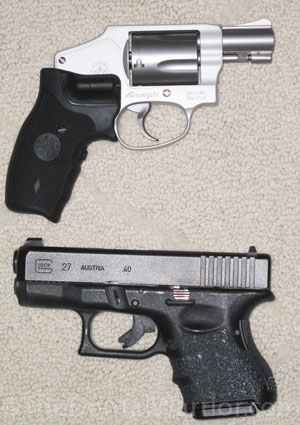
Top: Revolver
Bottom: Semi-auto pistol
The truth is that I really can’t recommend any particular gun to anyone.
What I like, you may hate. What’s right for you depends on a number of factors, including:
- What fits your hand.
- Can you operate the controls easily?
- What you can shoot comfortably and proficiently.
- Sensitivity to recoil (aka “kick”).
- Do you plan on carrying it concealed? Where? How? How do you dress?
- Is it for home defense?
- Will you be “sharing” the gun (with a spouse)?
- Budget?
Do Your Homework!
I have long advocated taking a basic pistol handling class. Typically, these classes have a variety of handguns available for students to try. Quite simply, the best way to find the best type of gun for you is to “try before you buy.” Some ranges have guns available for rent, which is another way to see what you like. However, I will attempt an introduction to handguns that you may find useful before dipping your toes in the gunpowder.
Revolvers vs. Pistols
Let’s get down to the two basic types of handguns: revolvers and pistols. They are easily visually and functionally distinguished.
Revolvers
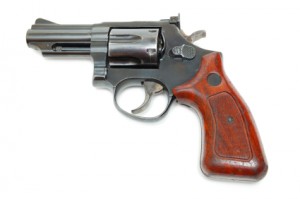
Revolvers, also sometimes called “wheel guns,” have a prominent and visible cylinder in which 5 to 8 rounds of ammunition are loaded. At each trigger pull, the cylinder rotates and puts the next round in front of the hammer to be fired.
Advantages
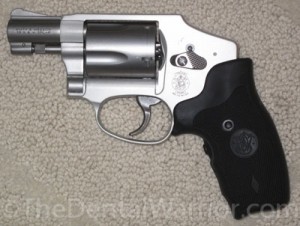
Smith & Wesson 642 Airweight (.38-Special)
Revolvers generally are believed to be more reliable than semi-auto pistols. It’s true… and considered a significant advantage of revolvers. They are also easier (simple) to operate. Once it’s loaded, you just pull the trigger. There are no safety levers, magazine or slide releases.
Revolvers generally don’t “jam.” So, there are no “jam-clearing” procedures to be learned. However, they CAN malfunction and lock up. Ask me how I know. So, don’t believe anyone who tells you, “revolvers never malfunction.”
And, clearing a jammed revolver is not easy. You won’t be able to do it in a shit-hit-the-fan scenario. A jammed semi-auto pistol (see below) can be cleared easily and quickly (once you know how) right then and there… and be back in action against the bad guy. Though such jams are fairly rare with a reliable semi in the hands of a properly-trained shooter.
Revolvers are easy to use, as their design is very simple. If your first gun is for home defense and it will be “shared” (used by your significant other), a large-framed revolver is a great choice. Revolvers are also easier to maintain, as they don’t require any dis-assembly.
Disadvantages
The big disadvantage of a revolver is that it has a lower ammunition capacity (5 to 8 rounds, typically). Another disadvantage of a revolver is that it can be more challenging to conceal due to the profile of the cylinder (thicker than most semi-auto pistols)… if your plans include carrying concealed. Though it is not impossible. They can certainly be concealed.
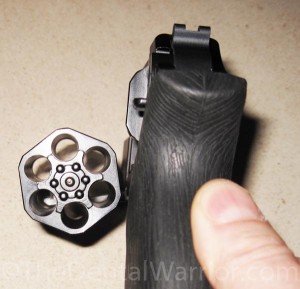
A view of the opened cylinder of a revolver. (Chiappa Rhino 200DS)
Click image to read a review of this revolver.
Also, revolvers are more difficult when it comes to “tactical reloads.” That means when the shit hits the fan, and you’re out of ammo, loading a revolver cylinder takes longer and can be more difficult when your body is loaded up with adrenaline (manual dexterity is greatly diminished). Feeding rounds into the holes in the cylinder can be a challenge if your hands are shaking from an adrenaline dump. However, there are devices called “speed-loaders” and “speed strips” that can make reloading much easier.
That all said, revolvers are considered by many to be ideal for beginners and first-time buyers. Smith & Wesson and Ruger make excellent revolvers. HOWEVER, you may find that a snub-nose revolver like the Smith & Wesson 642 Airweight pictured two pictures up on the right are often recommended to women for their first concealed carry gun. It’s generally a bad choice. While they are conveniently compact and lightweight, they have a harsh recoil. They KICK. A lot. Because of that, the new owner will tend to shy away from practice. Even for an experienced shooter like myself, practice with the S&W 642 Airweight gets tiresome and painful after about 20 rounds of practice at the range. Practice is important, so for a novice, a snub-nose may not be a good first choice. A larger framed gun will absorb recoil better and encourage more practice.
Semi-auto Pistols
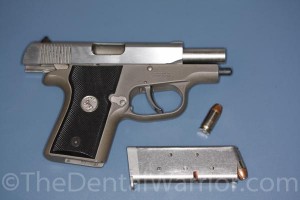
The pistol’s slide is locked back in this photo. Colt Pony Pocketlite (.380-cal)
Semi-auto pistols look quite different than revolvers. They have a slimmer profile. And, rather than a cylinder holding the ammunition, there is a box-shaped magazine that is inserted into the grip of the gun. On top, there is a “slide” that moves back and forth. This is how the gun loads the next round into the chamber to be fired. The first round is chambered by the user “racking the slide” (pulling it to the rear and letting it snap forward). When the first round is fired, the slide action automatically ejects the spent round and loads the next round in the chamber ready to be fired at the next pull of the trigger.
Advantages
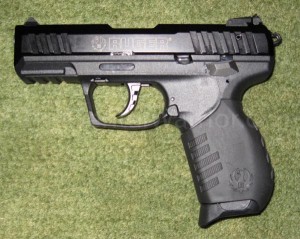
A semi-auto pistol, the Ruger SR-22 (.22LR caliber)
Semi-autos typically have higher capacities… 7 to 15+ rounds, depending on the size (of the frame) and caliber of the pistol. Semi-autos offer very quick and easy tactical reloads. You press the magazine release button and drop the empty magazine. Pop in a fresh magazine, rack the slide, and you’re ready to go. Semi-autos usually offer a flatter profile (thickness) for easier concealment.
Disadvantages
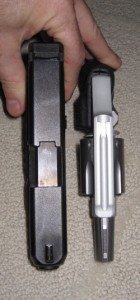
Note the difference in thickness / profile of a pistol (left) and a revolver (right).
Semi-auto pistols can malfunction (in a number of ways). So, it’s important to understand how and why they malfunction. If the SHTF (shit hits the fan), you’ll know how to clear the malfunction quickly and get back in the fight. The malfunctions can be misfeeds, jams, etc. Or, it can even be the magazine that malfunctions. All of these can usually be dealt with on the fly, if you’re prepared. Though, again… such jams should be quite rare.
Because the slide of a semi-auto pistol is spring-loaded, some people (with small or weak hand-strength) may find it difficult to operate.
Maintenance of semi-auto pistols is a bit more involved, as they require some dis-assembly (“field-stripping”) to clean and lubricate. However, most are fairly easy.
Semi-auto Pistol Variety
There are semi-autos that are very simple in design (fewer moving parts), such as Glock’s line of pistols.
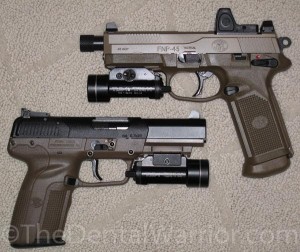
Pistols often have accessory rails which allow for adding of flashlights, lasers, or special optical sights.
And, there are semi-autos that are complex with a lot of moving parts, such as the classic Colt 1911, a .45-caliber (see below). You’ll find fans and haters of both.
Of course, there are other good brands, too.
Personally, I like Glock and FNH pistols. And, one reason is that they are VERY reliable. They just shoot and shoot and shoot. Malfunctions are extremely rare to non-existent. Smith & Wesson and Ruger also make some excellent and very reliable semi-autos.
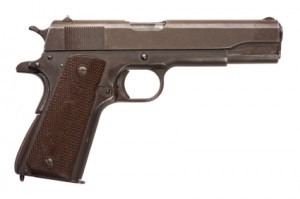
Colt 1911 (.45-cal) semi-auto pistol
I will dare to make this suggestion, especially for a new shooter: Don’t get a Colt 1911 style pistol for your first gun. They are a bit more complicated. You WILL find enthusiasts that think they are the ONLY type of pistol to get.
While there are many fine 1911 pistols available, I will simply argue it’s the wrong choice for most NEW shooters. Your mileage may vary. I’ve shot 1911s. They’re very cool. But I don’t own one…. yet. When I do get one, it will primarily be a “range gun.”
Care and Feeding
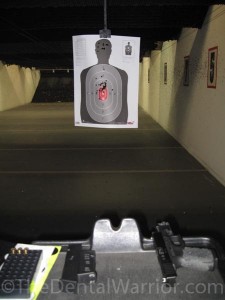
Range time!
If you’ve made the decision to arm yourself with a lethal weapon, I hope you’ll agree that proficiency and competence are important. And, to achieve that end, practice at the range should be part of your plan. The more practice you get, the more competent you’ll be… and, it’s FUN! You should also consider additional professional instruction. Simply buying a gun doesn’t make you a shooter, just as buying a piano doesn’t make you a musician.
Range time is important. Some people buy a gun, shoot it once (some never), and then either put it away at the house or carry it… without really being competent. That can be dangerous to themselves and others around them.
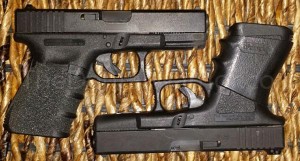
A Glock 23 (.40-cal) on top, and a Glock 19 (9-mm) on bottom.
Range time and cost: The real question is whether you have to buy ammo at the range, or will they let you bring your own? If they’re charging $10 – $20 (usually by the hour), and you can bring your own ammo, then that’s not too bad. But, some ranges require you to buy your ammo from them (and charge less for the range time), and they may charge a premium for the ammo (compared to buying it elsewhere). Costs can escalate quickly. However, some ranges are fairly reasonable. Some offer annual memberships that include unlimited range time, which can reduce your costs if you go often. Check around.
I buy most of my ammo online. And, if you start to shoot fairly often, it’s worth buying it in bulk online.
Which caliber? .38-Special… 9-mm… .40-cal…. .45-cal…
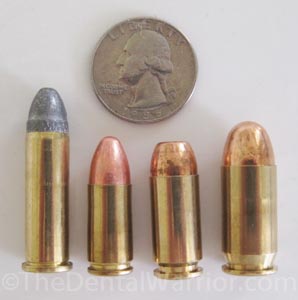
Left to right: .38-Special, 9-mm, .40-cal., .45-cal.
Another thing about ammo… it can affect your decision on purchasing a gun. Bigger calibers make bigger holes. Advocates of armed self-defense quip that bigger holes “let the bad out (of bad guys) faster.” Bigger calibers also make a bigger boom. And, that means more recoil. How much recoil can you tolerate and still shoot accurately? In a self-defense scenario, two hits with a smaller caliber is better than six misses with a larger caliber.
Besides deciding which caliber you are comfortable (and competent) shooting, you may consider the COST of practicing with that caliber. Different ammo calibers will cost varying amounts. From cheaper to more expensive: 9mm < .40-cal < .45-cal, for example.
(Edited to add: The pricing examples below may not reflect the current reality with prices fluctuating wildly due to the political influences at play. But, you can still consider how the prices are relative to each caliber.)
9-mm can cost from $10 – $13 for a box of 50.
.40-cal can cost ~$16 – $18.
.45-cal can cost ~$18 – $20.
I can easily go through 200 – 300 rounds in a range session of about an hour. Some shoot less. Some shoot more. It just depends on your experience and preferences.
Range ammo vs. self-defense ammo
I should mention the differences between range / practice ammo vs. self-defense (SD) ammo.
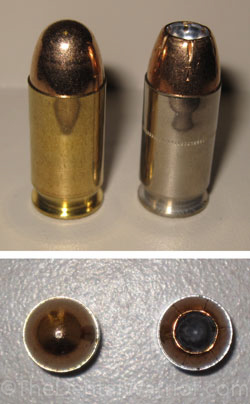
Left: Full metal jacket (FMJ) for range / practice.
Right: Hollow Point (HP) for self-defense.
Range ammo is typically FMJ (full metal jacket – lead covered by copper) or plain lead. It’s cheaper than self-defense (SD) ammo. And, it’s generally not appropriate for self-defense. It doesn’t expand on impact. It can even pass through the bad guy, possibly hitting someone else (innocent). And, that’s not good.
SD ammo is also known as hollow-point (HP). Hollow points are appropriate for SD because they expand (making a bigger hole in the bad guy and transferring more energy to the target). And, they don’t go THROUGH the bad guy, possibly causing collateral damage or casualties.
SD ammo is more expensive. Premium SD ammo can cost as much as a buck a round. You don’t usually use it for practice at the range. BUT, you SHOULD run (test) a couple boxes of it through your gun to make sure it functions reliably. This is especially true with a semi-auto pistol. It’s not really an issue with revolvers. Some semi-autos can be picky about SD / HP ammo. You don’t want to find out your semi-auto pistol jams up with a certain HP ammo at the worst possible time. Find a brand / model of HP your gun likes to eat. Once you’ve determined compatibility between pistol and SD ammo, you’re good-to-go and won’t need to practice with the expensive SD ammo.
Always use protection!
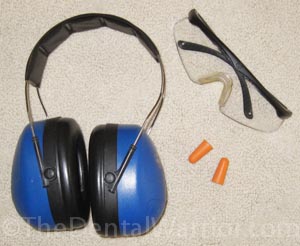
I prefer to double-up on hearing protection by using foam plugs and over-the-ear muffs.
It’s very important to use eye and ear protection at the range. We only get one set of eyes and ears, and damage to either is usually irreversible. Buy your own glasses and ear muffs. Don’t cheap out! Even high quality protection is relatively inexpensive. Ranges have rentals. But, I don’t like to put rental gear on my face that has someone else’s sweat all over it. Yuck!
One more pearl: Wear a baseball cap! Ejected brass shells (HOT!) are a bit unpredictable in their trajectory. It’s not only your own brass, but it could be from the shooter in the next lane over. I’ve seen them lodge between eye glasses and cheeks or eyebrows, leaving a nasty burn. But, they’ll bounce right off the brim of your baseball cap.
Another pearl for the ladies: Don’t wear low-cut tops or open shoes at the range… for the same reason I recommend baseball caps. I’ve seen ladies doing quite a dance when hot brass lands in their cleavage. Never mind that dancing around with a loaded gun in your hand adds danger to yourself and those around you. PUT THE FIREARM DOWN ON THE BENCH… Then dance all you want. Put the gun down first!!
UPDATE to this section: Woman Shoots Fiance in Leg at Range after Hot Casing Lands in Blouse!
UPDATE #2: A very sad story – Teen accidentally killed at gun range by dad’s bullet
Maintenance
Guns require maintenance to remain reliable. Cleaning and lubricating your guns will keep them running and prevent damage from corrosion. You don’t want a gunked-up gun to malfunction on you at the worst possible time. If you carry a gun concealed, you’ll need to clean it occasionally even if you haven’t fired it in a while (due to lint and other dirt that accumulates). Read the manual and keep it clean and shiny.
Bet you can’t shoot just one!
In the end, you may discover that one gun isn’t enough, because one gun isn’t ideal for a variety of purposes. You may find that a gun that is great for home protection doesn’t serve well as a carry piece. Likewise, you may find a particular gun is ideal for range practice and not so much for home protection. And, so on. There’s nothing wrong with owning multiple guns for multiple purposes.
Now get out there and exercise your 2nd Amendment Right!
So, there you go… a primer on choosing and using your first gun. I hope you found it helpful. Again… Take a class, and try before you buy. Also, you can rent a variety of guns at most ranges (after you’ve taken the class). Learn and commit to memory the rules of safe gun handling.
If I missed anything, or you have questions, feel free to post them in the comment section below!
PS… You may also like these articles about guns:
Why You Shouldn’t Listen to Bad Advice on Self-defense
Everyone Should Have a .22-LR in Their Collection
Is the Gun Loaded? It Doesn’t Matter!
Why I “Need” an AR-15
Save Your Own Life with Situational Awareness
My Appearance on CNBC’s Special About the AR-15
 Copyright protected by Digiprove © 2013-2020 The Dental Warrior®
Copyright protected by Digiprove © 2013-2020 The Dental Warrior® 
Good quick, down and dirty guide to picking the right firearm. Next weekend I get a “Husband Pass” to shoot an IDPA match at my range. It is a great time and good training.
Thanks, Michael! I’ve been meaning to do this for a long time. Now, when I get those emails with questions, I can just link to this! 🙂
Very timely post Mike, especially with all the political posturing going on right now. Here in Hartford, CT, approximately 90 minutes from Newtown there is no shortage of opinions on this subject. But I suspect it is like that everywhere in this country. Your information is valuable to dentists and non-dentists. Thank.
Thanks for chiming in, Nicholas. It’s puzzling to me that many of the states in the northeast are VERY restrictive when it comes to the 2nd Amendment…. Considering they are the very birthplace of the Revolutionary War, when the Brits tried to disarm the Patriots.
If you ever get to come to Houston to lecture let me know. I’ll take you to a nice outdoor and provide the guns and ammo!!! 🙂 Look forward to meeting you in April at the Townie event.
Pingback: Why I “Need” an AR-15 | The Dental Warrior® – A Blog for Dentists
Pingback: Why You Shouldn’t Listen to Bad Advice on Self-defense | The Dental Warrior® – A Blog for Dentists
Pingback: Everyone Should Have a .22-LR in Their Collection | The Dental Warrior® – A Blog for Dentists
I’m with you, except the price on ammo is, unfortunately dated. Partly due to the massive accumulation of ammo by friendly sources like Homeland Security. Right now you are lucky to get a box of 9 for $27.50! Unbelievable…and sad.
Currently, my wife uses a Ruger LCR .38 special (5 shot) for home defense. My choice is a Glock 30 (.45 cal)…a manstopper for sure. I use it for CC as well as home defense.
My range gun is a tricked out Glock 17. I tweek everything myself and its a lot of fun. Easy too, since I have the necessary “small dental tools” to assist 🙂
Very nice blog article, keep it up!
Mike
Actually, the ammo shortage has NOTHING to do with Homeland Security. And, that’s a provable fact. The reason there’s a shortage is because WE THE PEOPLE have bought it all.
Ammo prices WILL go down. I predict they’ll drop BELOW where they were before the feeding frenzy. I’m sitting tight.
Fortunately, I stocked up before the frenzy. But, if the NSA is monitoring this blog, they should know that I lost all my ammo (and guns) in a tragic boating accident.
Pingback: Why Armed Self-defense? | The Dental Warrior® – A Blog for Dentists
Pingback: But, I Live in a Nice Neighborhood. | The Dental Warrior® – A Blog for Dentists
Mike what about a shotgun for home self defense? One dealer I spoke with suggested that “the pump sound of a Mossberg is the most recognizable sound and will have most burglars running for the door when they hear it” but is a shotgun really effective in stopping an intruder???
Yep… that’s the stuff of urban legend and Hollywood fantasy. It’s been repeated so many times, it’s believed to be true. It’s not. There is zero evidence that it’s true. No legitimate defense expert recommends “racking the shotgun” to scare off bad guys. It’s actually a bad idea for a couple of reasons. The first is that you’re giving away your location to the bad guy. That’s not good. Secondly, racking your pump-action shotgun means that either your chamber was empty, which means you’re one round short of a full load. Or, if the chamber was loaded, you just ejected a live round that’s no longer available to you. Most experts agree that your defense firearm should be loaded to “capacity + 1.” That means a full magazine AND one in the chamber… ready to use. There’s no reason to have a gun down 1 round and an empty chamber.
Shotguns are also often cited as “the best home defense gun.” It’s simply not true. There is no “best” home defense gun. Those who mistakenly advocate for a shotgun as “the best” will suggest or imply that you “can’t miss.” You sure as hell CAN miss with a shotgun. At typical home defense distances, the shot pattern will not spread very much. Buckshot will pattern at about 15-inches of spread at 15 yards. At 5 yards it’s only 4 – 5 inches of spread. Most home defense encounters are probably 5 yards, 10 yards max. So, you CAN miss. Shotguns aren’t magical, and they don’t compensate for poor marksmanship compounded by a huge adrenaline dump.
Also consider that long guns require two hands to operate. Defense encounters may be at VERY close range. You may need one of your hands to push the perp away. You may need a hand to operate a flashlight or hold a phone (calling 911). Long guns can be nearly useless if you’re facing the bad guy at “bad breath distance.”
Shotguns DO have advantages… and disadvantages, as do rifles and handguns. The biggest advantage of shotguns is that they deliver more energy (aka “stopping power”) than any handgun. A lot more. So, it just depends. It depends on your circumstances, environment, competencies, proclivities, preferences, biases, physical attributes, etc. Also consider that you may be “sharing” the gun with your significant other. Can he or she operate the gun competently and confidently?
Lots of factors in play. So, anyone who simply says, “Just get yourself a pump-action shotgun (or any other specific gun),” is not really giving good advice.
I think the Chiappa Rhino makes the most sense as a “first gun” for beginners. Looks simple….and less recoil. Also looks slim enough to conceal carry if you wanted to.
Hi Dr. Dan! Thanks for posting a comment!
While I believe a revolver makes sense for a lot of people as a first hand gun, I’m not sure a snub nose Rhino is the “one.” Chiappa has larger framed Rhinos, though. For home protection, a large frame revolver is a good choice. But, here’s the thing… If I had a choice, I’d probably recommend and go with a Smith & Wesson revolver, like the Model 686 in a 4″ or 6″ barrel length. The price is about the same for both, if I recall, and the S&W just can’t be beat for reputation, reliability, and value retention.
Hey Doc,
You mentioned buying ammo online. What site do you find has the best deals?
Hi Jeff! I have several that I have liked over the years. (There are MANY more out there.)
Some of my favorites (in no particular order):
http://www.SGAmmo.com
http://www.PalmettoStateArmory.com
http://www.MidwayUSA.com
http://www.natchezss.com
http://www.AmmoToGo.com
I will say that SGAmmo.com seems to have the best prices consistently. PalmettoStateArmory.com also has some good deals. Most of these guys have subscription features that will alert you to sales. You can also set up alerts on specific ammo.
I hope that helps!
Pingback: It’s a Plandemic! Do you know where your ammo is? | The Dental Warrior® – A Blog for Dentists